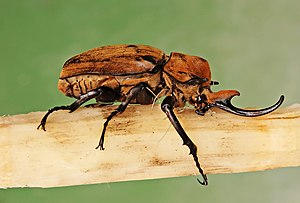Dynastini
| Dynastini | ||||||||||
|---|---|---|---|---|---|---|---|---|---|---|

Megasoma elephas , male |
||||||||||
| Systematics | ||||||||||
|
||||||||||
| Scientific name | ||||||||||
| Dynastini | ||||||||||
| MacLeay , 1819 |
Dynastini is a tribe within the subfamily of the giant beetles (Dynastinae). This group of beetles includes some of the largest and heaviest species, such as the Hercules beetle ( Dynastes hercules ) and the elephant beetle ( Megasoma elephas ).
features
The tribe Dynastini includes large to very large beetles (25–175 millimeters). Your body is more or less cylindrical. The color is usually black, but it can also be yellowish or reddish brown. The beetles show a very pronounced sexual dimorphism . The male is usually significantly larger than the female and has a long horn on the head, often one to three horns pointing forward on the front chest ( pronotum ). The males are almost always smooth and shiny, while the females are often dull and finely haired. The antennae are short and pointed outwards in a fan shape. The legs are quite long, especially the front legs can be elongated with long, sharp claws. The front pair of legs ( protibia ) has 2-3 sharp teeth on the outside of the end piece ( pretarsus ).
Way of life
All Dynastini live in forests in tropical or subtropical areas. The larvae usually develop in dead wood or mold and take several years to become a fully grown beetle. Despite their heavy body, these species fly well. They are most active at night, and that's when they usually come out. They feed on rotting fruits or plant juices. The males use their horns to fight over the females. It tries to get the horn under the opponent and to tip him on his back. This can explain why many species have evolved large horns in evolutionary terms .
These spectacular beetles are very popular with collectors and are also kept as exotic "pets". At least some of the species are relatively easy but time consuming to breed in captivity.
distribution
Dynastini are common in tropical and subtropical areas around the world, but they are almost entirely absent in Europe . In America , the group is common in the north to the south of the United States . Most species are found in Indonesia and Central America before
Systematics
About 100 species in 13 genera are included in the tribe Dynastini. These are assigned to the following three sub- groups:
- Chalcosomina Rowland & Miller , 2012
- Dynastina MacLeay , 1819
- Xylotrupina Hope , 1838
| Dynastini |
|
||||||||||||||||||||||||||||||||||||||||||||||||
|
|
The genres in alphabetical order:
- Allomyrina Arrow , 1911 - 4 species, Southeast Asia
- Augosoma Burmeister , 1841 - 2 species, Africa
- Beckius Dechambre , 1992 - a kind, Southeast Asia, is recently to Eupatorus expected
- Chalcosoma Hope , 1837
- Dynastes MacLeay , 1819
- Endebius Lansberge , 1880 - 2 species, Southeast Asia, oftencountedamong Xylotrupes
- Eupatorus Burmeister , 1847 - 7 species, Southeast Asia
- Golofa Hope , 1837 - at least 30 species, South and Central America
- Haploscapanes Arrow , 1908 - 4 species, New Guinea and Australia
- Megasoma Kirby , 1825
- Pachyoryctes Arrow , 1908 - 2 species, Southeast Asia
- Trypoxylus Minck , 1920
- Xylotrupes Hope , 1837 - 20 species, Southeast Asia and Australia
Types (selection)
A selection of species with their area of distribution:
- Hercules beetle ( Dynastes hercules ( Lachaume , 1985)) - Central and northern South America
- Dynastes hyllus Chevrolat , 1843 - Mexico
- Dynastes maya Hardy , 2003 - Mexico
- Dynastes miyashitai Yamaya , 2004 - Mexico
- African Hercules beetle ( Augosoma centaurus ( Fabricius , 1775)) - West and Central Africa
- Eupatorus sukkiti Miyashita & Arnaud , 1996 - Myanmar
- Golofa gaujoni Lachaume , 1985 - Ecuador
- Golofa globulicornis Dechambre , 1975 - Panama
- Golofa solisi Ratcliffe , 2003 - Costa Rica
- Golofa xiximeca Morón , 1995 - Mexico
- Elephant beetle ( Megasoma elephas Bolívar , 1963) - Mexico to Venezuela
- Megasoma thersites LeConte , 1861 - Mexico
photos
literature
- Mark Rowland: Phylogeny and systematics of the giant rhinoceros beetles (Scarabaeidae: Dynastini) . Kelly B Miller, November 2012 (English).
Web links
other projects
General
- Image gallery for Dynastinae. Buguide, accessed on November 12, 2018 .
- Pictures to species. Retrieved November 12, 2018 .
- MacLeay: Dynastini MacLeay, 1819. In: BioLib.cz. Retrieved November 28, 2018 .
Video
Individual evidence
- ^ WS Macleay: Horae entomologicae: or essays on the annulose animals. Containing geneal observations on the geography, manners, and natural affinities of the Insects which compose the genus Scarabaeus of Linnaeus; to which are added a few incidental remarks on the genera Lucanus and Hister of the same author. With an appendix and plates . 1. Part 1. S. Bagster, London 1819, p. 64 (English).
- ↑ Dynasini - occurencies. Global Biodiversity Information Facility, accessed November 11, 2018 .
- ^ Tribus Dynastini MacLeay, 1819 . www.biolib.cz. Retrieved November 13, 2018.








